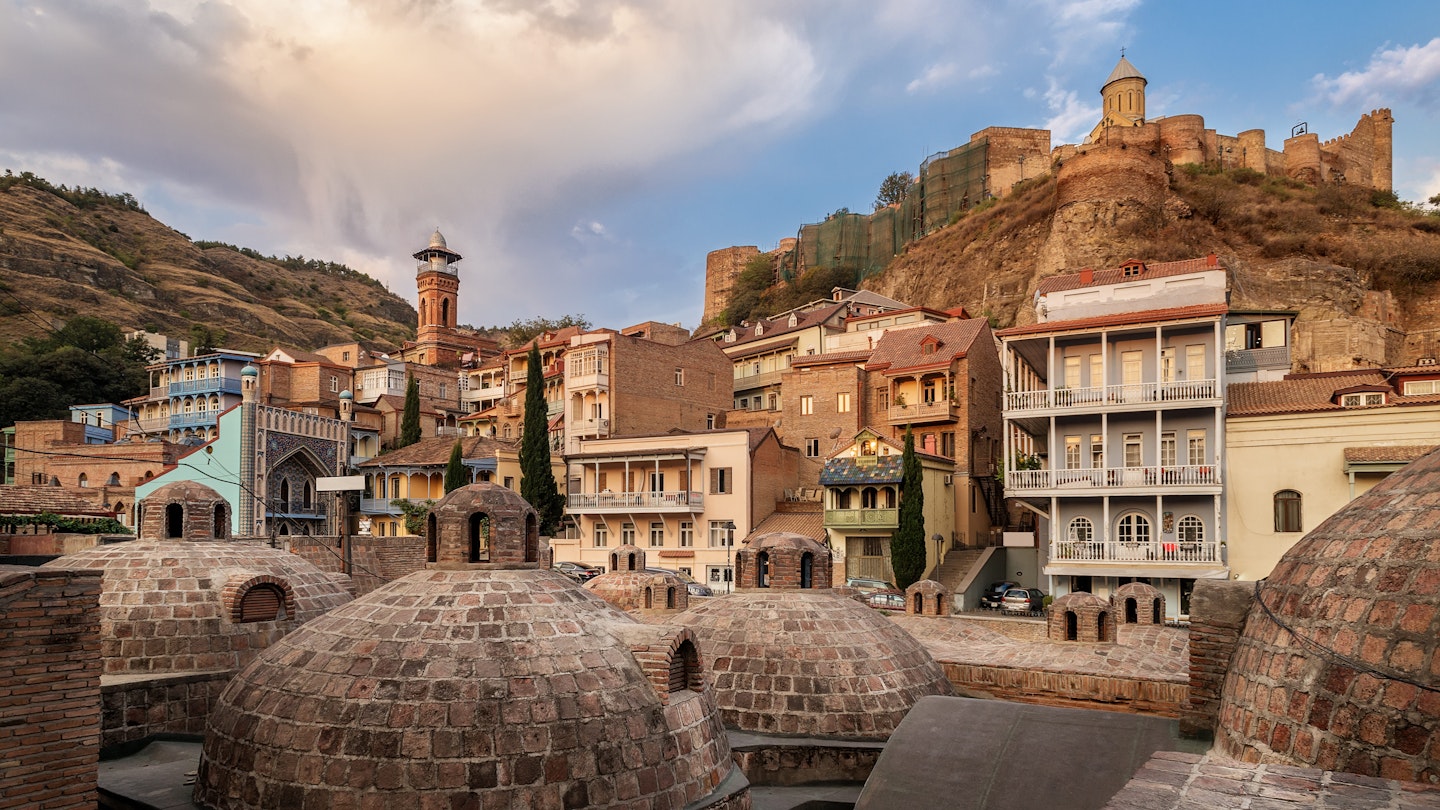A compelling blend of European and Asian influences, Georgia’s capital is a compact destination easily explored in a few days. Alleys and lanes meandering from the riverside Old Town lead to a spectacular hilltop fortress, and ground-breaking modern design counters stately avenues and heritage architecture. Moreover, culinary influences and flavours from the surrounding region filter through the city’s restaurants and markets. Here are ten experiences you shouldn’t miss on a trip to Tbilisi.

1. Marvelling at Horizon-Stretching Views
Reaching Tbilisi’s best views is an adventure in itself. A funicular railway trundles up a vertigo-inducing cliff face to the top of Mt Mtatsminda. From the terminus, well-tended gardens and walkways lead to Mtatsminda Park, where one can enjoy amusement park attractions, including a Ferris Wheel. Visitors can stop at Funicular Cafe to indulge in ponchik (doughnuts stuffed with sweet cream) served with tea or head next door to the Georgian restaurant Chela for lunch. Both places offer outdoor seating, allowing diners to take in the stunning views of the city’s diverse architecture.
2. Immersing Yourself in Modern Architecture
Tbilisi’s architectural landscape boasts a vibrant collage of faded Art Nouveau apartments, grand 19th-century wooden buildings, and Soviet-era tower blocks. A stroll across the Mtkvari River on the Peace Bridge immerses one in an elegant web of steel and glass. Visitors should also explore Rike Park, home to stunning tube-like structures designed by Italian architect Massimiliano Fuksas. These twin metallic buildings, originally intended as a concert hall and exhibition space, are a testament to innovative design.
3. Meeting Mother Georgia
On the Mtkvari’s northern bank, a gondola system offers panoramic views as it glides over the river and rises above the Old Town towards Narikala Fortress. This craggy remnant includes both 4th-century Persian and 8th-century Arab fortifications. Following the pathway, you will find charming vendors selling freshly-squeezed pomegranate juice before arriving at Kartlis Deda (Mother Georgia). This 20m-high statue, holding a cup of wine in one hand and a sword in the other, symbolizes the welcoming yet resilient spirit of the Georgian people.
4. Wandering the Old Town’s Meandering Streets
Winding downhill from Freedom Square, Tbilisi’s Old Town exudes charm with its wooden structures, ornate verandas, and narrow shopfronts filled with cafes, wine bars, and art galleries. While some areas are being gentrified, a detour reveals the traditional life where the aroma of freshly-baked bread wafts from local bakeries, and vendors sell spices, fruits, churchkhela (strings of nuts coated in caramel), and seasonal produce under age-old plane trees.
5. Uncovering a Centuries-Old Wine Tradition
With a winemaking culture that dates back 8,000 years, Georgia is renowned as one of the world’s original viticulture cradles. Traditional wine is aged in beeswax-lined terracotta urns known as qvevri that are buried to ensure stable fermentation. The process of incorporating grape skins creates distinctive and flavorful wines with amber hues. Vino Underground, located near Freedom Square, is an ideal spot to begin exploring the unique tastes of Georgian natural wine, and local experts from Living Roots can arrange vineyard visits throughout Georgia.

6. Tasting Silk Road-Inspired Cuisine
Strategically positioned on the ancient trade route between Europe and Asia, the food of Georgia is a fusion of culinary influences from neighboring countries. Khinkali, robust savory dumplings, are traditionally enjoyed with beer, while traditional bread is often cooked in wood-fired ovens akin to Indian tandoors. Dishes like chakapuli, a fragrant lamb stew flavored with dill, tarragon, and sour plums, reflect Iran’s influence. For a modern twist on Georgian flavors, try dining at Shavi Lomi, Veriko, Restaurant Meama, or Barbarestan.
7. Pausing for Incense-Infused Reflection
Constructed in the 6th century and surrounded by a picturesque riverside garden, Anshiskhati Basilica is Tbilisi’s most atmospheric church. Afternoon light pours into the compact interior, illuminating centuries-old art treasures, icons, and frescoes. The gentle aroma of incense adds to the serene atmosphere, and visitors might be lucky enough to hear worshippers perform traditional three-voice polyphonic chants.

8. Hunting for Treasure at the Dry Bridge Market
Vivid reminders of the Soviet era can be found at Tbilisi’s Dry Bridge Market, where blankets and tarpaulins display an eclectic collection of memorabilia. Collectibles like enamel badges and retro cameras sit alongside Soviet-era artifacts, including faded album covers of renowned bands spelled out in Cyrillic characters. Although weekends offer the widest selection of items, there is much to discover from Monday to Friday as well.
9. Taking a Journey Through Georgia’s Past
The Georgian National Museum showcases crucial exhibitions exploring both ancient and modern history. Visitors can marvel at the Archeological Treasury, which boasts delicate gold jewelry, and engage with the Museum of the Soviet Occupation on the top floor, detailing the region’s 70-year experience of Soviet rule. The displayed footage of the 2008 war in South Ossetia highlights the ongoing relevance of this historical narrative.
10. Revitalising at the Sulphur Baths
Tbilisi’s hilly landscape makes exploring the city’s narrow streets an invigorating experience. Therefore, a perfect way to unwind is to spend a few hours in Tbilisi’s renowned Abanotubani sulphur baths. In this complex adorned with elegant brick domes, visitors can choose between shared public baths or more private options that include saunas and body scrubs. It’s advisable to enjoy a cup of tea to stay hydrated while enjoying the therapeutic properties of the steaming sulphur-infused pools.
Article first published in July 2016 and last updated by Baia Dzagnidze in February 2020.





